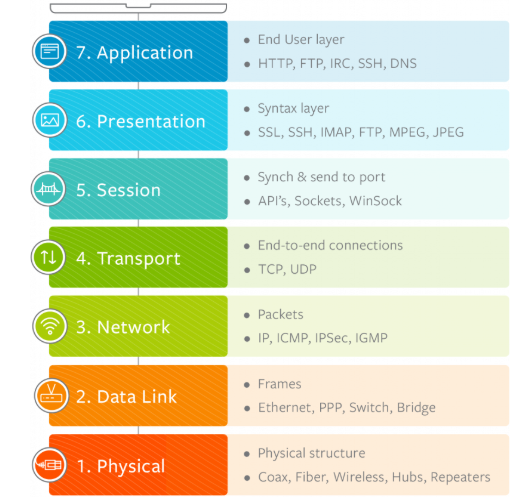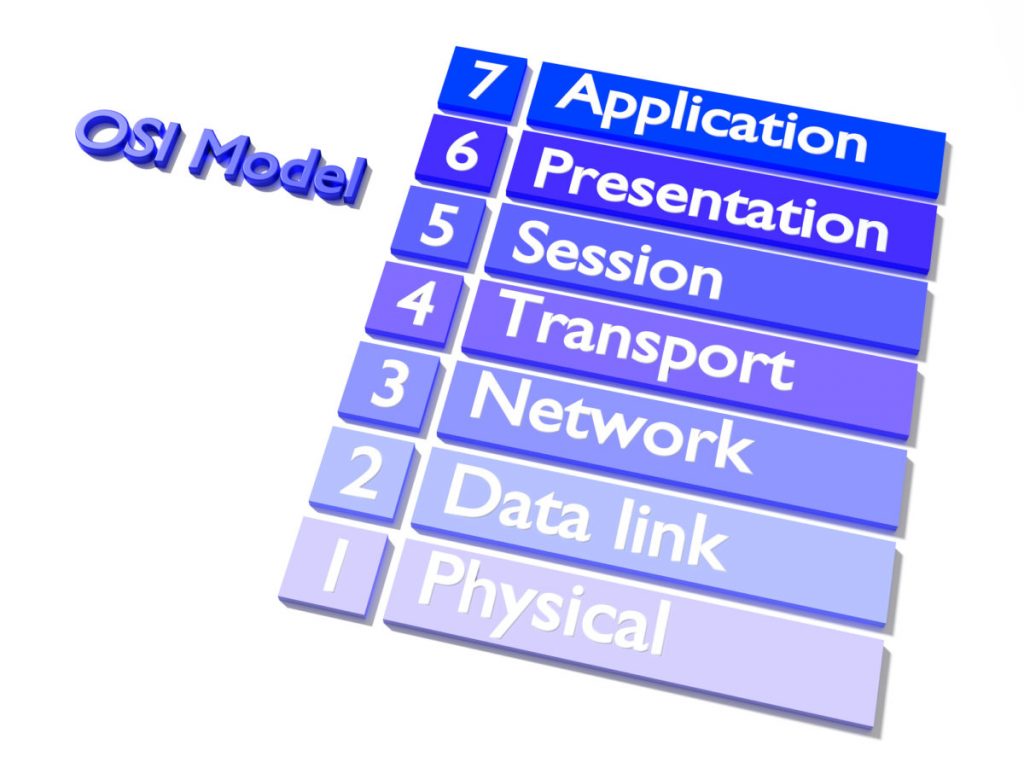What is The OSI Model?
The Open Systems Interconnection (OSI) Reference Model is a conceptual construct that defines networking or telecommunication system functions independently of the technology infrastructure underlying them. It divides data communication into seven abstraction layers and standardizes protocols into appropriate network functionality groups. This is to ensure interoperability within the communication system regardless of the type, vendor, and model of the technology involved. Initially, the OSI model is design to promote interoperability between vendors, and to define consistent network communication standards. The older TCP / IP model, however, remains the standard frame of reference for Internet communication today.
The 7 layers of the OSI model
This image illustrates the seven layers of the OSI model. Below, we’ll briefly describe each layer, from bottom to top.

Physical
The lowest layer of the OSI model is concerned with data communication in the form of physically transmitting electrical, optical, or electromagnetic signals between networking devices and infrastructure. The physical layer is responsible for the communication over a physical media of unstructured raw data streams.
It sets out a few aspects including:
- Electrical, mechanical, and physical systems. And networking devices that include specifications such as cable size, signal frequency, voltages, etc.
- Topologies such as Bus, Star, Ring, and Mesh
- Communication modes such as Simplex, Half Duplex, and Full Duplex
- Data transmission performance, such as Bit Rate and Bit Synchronization
- Modulation, switching, and interfacing with the physical transmission medium
- Common protocols including Wi-Fi, Ethernet, and others
- Hardware including networking devices, antennas, cables, modem, and intermediate devices such as repeaters and hubs
Data Link
The OSI model’s second layer involves data transmission between nodes inside a network. And handles the links between physically connected devices such as switches. The raw data obtain from the physical layer is cluster. And pack into data frames containing the necessary protocols for routing information between the nodes concern.
The data link layer is further divided into two sublayers:
- The sublayer of Logical Link Control (LLC) is responsible for flow controls and error controls ensuring error-free and accurate data transmission between the network nodes.
- The sublayer Media Access Control (MAC) is responsible for managing access and data transmission permissions between the network nodes. The data is transmit sequentially, and the layer expects recognition of the encapsulate raw data transmit between the nodes.
Network
The OSI model’s third layer arranges and transmits data among multiple networks. The network layer is responsible for routing the data through the best physical path, based on a range of factors including network features, best available path, traffic controls, data packet congestion, and service priority, among others. To distinguish between the source and destination networks, the network layer provides logical addressing for data packets.
Other functions include encapsulation and separation, management of congestion and the handling of errors. Outgoing data is divided into packets and incoming data is reassembled into information which can be consumed at a higher level of application. Hardware on the network layer includes routes, bridge routers, 3-layer switches, and protocols. For example, Internet Protocol (IPv4) version 4 and Internet Protocol version 6 (IPv6).
Transport
The fourth layer of the OSI model ensures full and reliable data packet delivery. The transport layer provides mechanisms. For example, error control, flow control and congestion control. To keep track of the data packets, check for errors and duplication, and resend information failing delivery. It involves the service-point addressing function to ensure that the packet is sent (via a port address) in response to a particular process. Packet segmentation and reassembly ensure the data is separated. And sent sequentially to the destination where it is tested for validity and consistency based on the receiving sequence.
Popular protocols include the Transmission Control Protocol (TCP) for connection-oriented data transfer, and the User Datagram Protocol (UDP) for connection-free data transfer.
Session
The session layer handles sessions between clients to facilitate communication, as the first of three layers dealing with the machine stage. Session refers to any interactive networked exchange of data between two entities. Common examples include HTTPS sessions that allow Internet users to visit and browse websites over a given period. The Session Layer is responsible for several functions including opening, closing, and resetting session activities, authenticating and authorizing contact between specific apps and servers, defining full duplex or half duplex operations, and synchronizing data streams.
Common Session Layer protocols include Remote procedure call protocol (RPC), Point-to-Point Tunneling Protocol (PPTP), Session Control Protocol (SCP), and Session Description Protocol (SDP)
Presentation
The OSI model’s sixth layer converts data formats in between applications and networks. Presentation layer responsibilities include data conversion, the translation of character code, data compression, encryption, and decryption. The layer of presentation, also called the syntax layer, maps the semantics. And syntax of the data in such a way that the information receive is consumable for each distinct network entity.
For example, before it is sent across the network. The data we transfer from our encryption-based communication app is format and encrypt at this layer. At the receiving end the data is decrypt and convert as originally intend into text or media content. The layer of presentation serializes complex information into transportable formats. Then, the data streams are deserialize and reassembled at the destination into original object format.
Application
The application layer includes the application-level networking processes. This layer communicates directly with end-users to provide support for, among other distributed information services, email, network data sharing, file transfers and directory services. The uppermost layer of the OSI model defines networking organizations to facilitate end-user requests for networking, assess availability of resources, synchronize communication, and handle application-specific networking requirements. This is to authentication, privacy, service quality, networking devices and data syntax.
Common application layer protocols include File Transfer Protocol (FTP), Simple Mail Transfer Protocol (SMTP) and Domain Name System (DNS).



